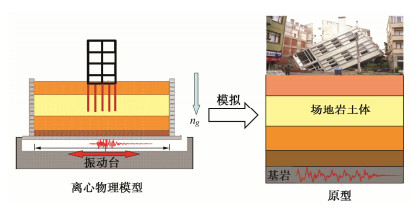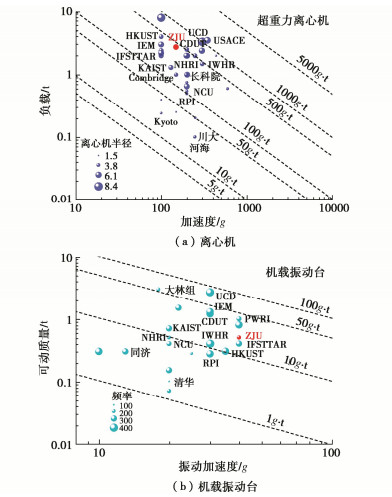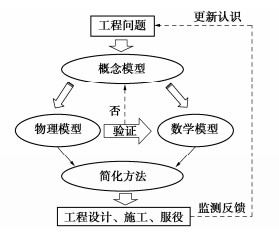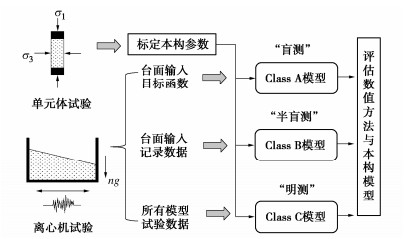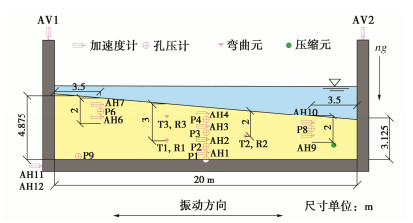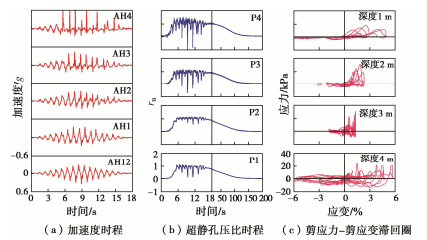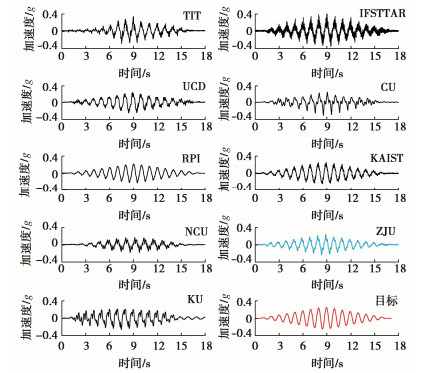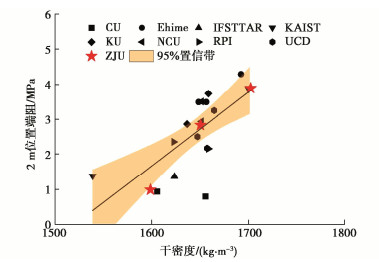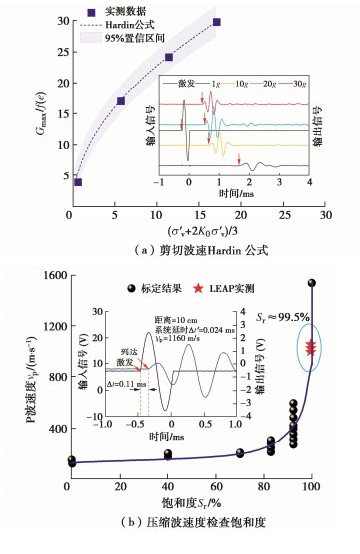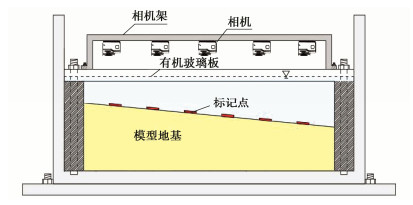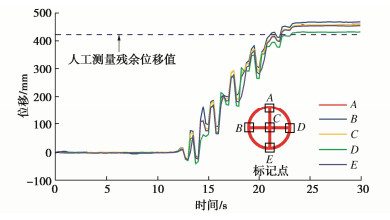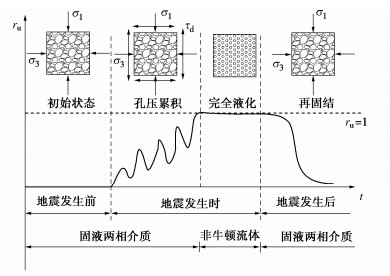Centrifugal shaking table tests on soil liquefaction and progress of LEAP projects
-
摘要: 离心机振动台模型试验是研究地震液化问题的重要手段,一方面可重现场地地震响应和揭示液化致灾规律,为发展工程设计方法提供依据;另一方面可以作为特定边值问题的标准模型试验数据,验证数值方法与土体本构模型及其参数选取的合理性。介绍了离心机振动台模型试验的试验原理,回顾了离心机振动台模型试验在地震液化领域的主要研究进展。围绕由中国、美国、日本和英国等国家高校与研究所联合开展的国际合作项目“液化试验与分析”(LEAP),重点介绍了若干为提高离心机振动台模型试验可重复性而发展的物理模拟新技术,包括离心机振动台的台面振动控制技术、模型土体弹性波速测试技术和基于图像分析的动态位移监测技术等。最后针对地震液化领域的若干工程和研究需求,探讨了离心机振动台模型试验领域的发展趋势。Abstract: The centrifugal shaking table test is one of the most promising approaches to study soil liquefaction problems. On one hand, it can reproduce seismic response and reveal the ground failure mechanism induced by soil liquefaction, providing the scientific basis for developing the design methods for engineering practices; on the other hand, the test results can verify the relevant methods and constitutive models for soils used in numerical simulation. The principles of the centrifugal shaking table tests are briefly introduced and the research progress of centrifuge modeling for soil liquefaction problems are reviewed. Then the liquefaction experiments and analysis project (LEAP) and its verification and validation procedures are described. The new techniques developed to improve the repeatability of the centrifugal shaking table tests are introduced, including the shaking control of the shaking table, measurements of elastic wave velocities under high centrifuge acceleration, and particle image velocimetry (PIV)-based real-time monitoring of dynamic displacements. Finally, the research trends of the centrifugal shaking table tests in the field of soil liquefaction are discussed.
-
Keywords:
- liquefaction /
- centrifugal model test /
- physical modeling /
- shaking table /
- VELACS /
- LEAP /
- scaling law
-
0. 引言
各向异性是黏土的基本性质之一,分为原生各向异性和次生各向异性。针对原生各向异性对黏土力学性状的影响,许多学者对与沉积平面呈不同夹角试样进行压缩、无侧限压缩和三轴压缩等试验,发现原生各向异性对黏土变形以及强度特性的影响不容忽视。
小应变剪切模量特性作为土的重要力学性质之一,也同样受到原生各向异性的影响。Simpson等[1]的研究表明,小应变剪切模量的原生各向异性对隧道及基坑周围土体变形的预测结果影响很大;Jovičić等[2]和吴宏伟等[3]分别针对伦敦黏土和上海软黏土进行研究,利用弯曲元测得两种土在低围压下水平和竖直方向上的最大剪切模量比值分别为1.5和1.21,说明对于不同种类黏土,原生各向异性对其小应变剪切模量的影响不尽相同。
结构性黏土在我国东南沿海地区分布广泛,许多工程建设涉及到此类黏土,迄今已对其小应变剪切模量进行了诸多研究,但以往的研究主要考虑孔隙比、应力水平和结构损伤等对小应变剪切模量的影响[4],而考虑原生各向异性对小应变剪切模量影响的研究较少,有必要进行系统探究。
本文对不同削样方向的湛江黏土原状试样开展不同围压下的共振柱试验,研究原生各向异性对最大动剪切模量的影响以及考虑原生各向异性的最大动剪切模量随围压演化规律的表征方法。
1. 试验材料与试验方案
1.1 试验材料与试样制备
土样取自湛江市某基坑内地下10~11 m,尺寸为30 cm×30 cm×30 cm原状块状样。表1为其基本物理力学指标与颗粒组成。由表1可见,湛江黏土具有较差物理性质,与软黏土相似,但力学性质较优,呈现上述特性的原因为其具有的强结构性[4]。
表 1 湛江黏土平均物理力学性质指标与颗粒组成Table 1. Physical and mechanical indexes and particle composition of Zhanjiang clay重度γ/(kN·m-3) 含水率w/% 孔隙比e 渗透系数K/(cm·s-1) 液限wL/% 塑限wP/% 塑性指数IP 结构屈服应力σk/kPa 无侧限抗压强度/kPa 灵敏度St 颗粒组成/% >0.05/mm 0.005~0.05/mm 0.002~0.005/mm <0.002/mm 17.1 52.98 1.44 2.73×10−8 59.6 28.1 31.5 400 143.5 7.2 8.2 39.5 20.7 31.6 图1(a)为不同方向圆柱试样示意图,定义试样轴线与土体沉积平面夹角为
α ,即竖直方向试样为90°,水平方向试样为0°。针对α 为0°,22.5°,45°,67.5°,90°方向原状样进行研究,试样规格尺寸为直径50 mm,高度100 mm的圆柱体。1.2 试验方法
试验所用设备为GDS共振柱仪,如图1(b)所示。试样的边界条件为一端固定,一端自由。通过电磁驱动系统对试样逐级施加扭矩,测得试样的共振频率和对应的剪应变,试样动剪切模量由下式得到:
G=ρ(2πfH/β)2, (1) 式中,G为试样动剪切模量,ρ为试样密度,f为共振频率,H为试样高度,β为扭转振动频率方程特征值。
试样在抽气饱和后安装至共振柱仪上,随后进行反压饱和,当B值达0.98后,进行固结,围压分别设定为50,100,200,300,400,500,600,700,800 kPa。试样固结完成后,进行共振柱试验。
2. 试验结果与分析
2.1 不同方向试样G-
γ 曲线规律如图2所示,不同方向试样动剪切模量G和剪应变
γ 的关系曲线形态与规律类似。剪切模量在小剪应变下衰减速度较小;随剪应变发展,衰减速度增大。低围压下G-γ 曲线随围压增大而上移,围压超过600~700 kPa,G-γ 曲线随围压增长而下移,与通常软黏土G-γ 曲线大多随围压增大而单调上移规律存在明显差异,说明结构性对湛江黏土G-γ 曲线规律影响较大。2.2 原生各向异性对最大动剪切模量的影响
湛江黏土动应力-应变关系可用Hardin-Drnevich双曲线模型表征,如下式:
τ=γa+bγ, (2) 式中,a,b为拟合参数。式(2)可以写为
1/G=a+bγ。 (3) 式(3)中,当
γ 趋近于0时,得到最大动剪切模量Gmax=1/a,利用式(3)求得不同方向试样在各围压下的Gmax。为了消除孔隙比对Gmax的影响,引入孔隙比函数F(e)=1/(0.3+0.7e2)将Gmax进行归一化处理,图3为经孔隙比函数归一化的Gmax/F(e)-围压σ3 曲线。随围压增大,不同方向试样Gmax/F(e)-σ3 曲线均呈现先上升后下降的规律,在围压为400~500 kPa即在σk 左右时,曲线出现转折。为了更好描述原生各向异性对最大动剪切模量的影响,定义Gmax/F(e)的原生各向异性系数:
Kα=Dα/D90°, (4) 式中,Dα定义为α方向试样的Gmax/F(e),D90°定义为90°(竖直)方向试样的Gmax/F(e)。
Gmax/F(e)的原生各向异性系数Kα与围压的关系如图4所示。相同围压下,Kα随方向角
α 变化,Kα整体上随α 增大而减小,即试样的方向越靠近水平其刚度越大,说明原生各向异性对湛江黏土最大动剪切模量Gmax的影响十分显著。湛江黏土基本单元为扁平状片堆、粒状碎屑矿物与单片颗粒,上述基本单元在沉积时,其长轴更倾向于水平方向,导致颗粒间水平方向的接触更紧密,结构更强[3],进而更靠近水平方向试样的刚度更大。当围压低于400~600 kPa时,同一方向试样Kα随围压增长基本保持恒定,K0°,K22.5°,K45°,K67.5°,K90°分别为1.314,1.279,1.148,1.045,1;当围压高于400~600 kPa时,同一方向试样Kα随围压增长呈明显减小趋势,不同方向试样的Gmax/F(e)差异减小。说明围压低于
σk 时,围压的增大几乎不影响原生各向异性对Gmax的影响,但当围压超过σk 后,围压的增大减弱了原生各向异性对Gmax的影响。文献[2]中伦敦黏土在围压超过屈服应力后,其水平与竖直方向试样的最大剪切模量的差异随围压增长也呈减小趋势,与本文试验结果一致。2.3 考虑原生各向异性的最大动剪切模量表征方法
图3中出现Gmax/F(e)随围压增大呈先上升后下降的特殊现象,文献[4]认为Gmax同时受到平均有效应力、孔隙比和结构损伤的影响,采用该文的表征方法对试验结果进行分析,具体的表达形式如下所示:
Gmax/F(e)=A(1+(σ′mpa)n)1+B(1+(σ′mpa)n)(kr+1−kr1+(ησ′mpc)λ)。 (5) 式中 A,B,n,kr,η和
λ 为反映各种应力历史和土体性质的参数;σ′m 为围压;pa为标准大气压;pc为表观前期固结压力即结构屈服应力σk ,不同方向试样压缩试验得到的σk 差异较小,均取400 kPa。采用式(5)将不同方向试样Gmax/F(e)与围压的关系进行定量表征。从图4可得,高应力下各向异性对试样的Gmax/F(e)影响减弱,可假定不同方向试样Gmax/F(e)极限值相同。最终将试验数据与拟合曲线一同绘制于图5,发现拟合效果很好,拟合参数见表2。
表 2 不同方向试样拟合参数Table 2. Fitting parameters of specimens in different directionsα A/MPa B n kr η λ R2 0° 39.92489 0.16678 0.54309 0.35092 0.56433 6.42998 0.99251 22.5° 37.89951 0.15999 0.58264 0.35462 0.56426 6.37147 0.99075 45° 33.76328 0.15168 0.54642 0.37740 0.55402 6.38473 0.99432 67.5° 31.15476 0.15761 0.56254 0.42499 0.60889 6.07737 0.99727 90° 29.75422 0.15743 0.56067 0.44448 0.57750 6.05669 0.99835 分析表2中拟合参数与试样方向的关系,可得参数A,kr,
λ 和试样轴线与土体沉积平面夹角α 呈线性关系(图6),参数B,n,η随α 增大分别保持在0.1587,0.5591,0.5738上下,且波动范围较小(参数B,n,η的标准差S分别为0.005455,0.01570和0.02131)。将图6中参数A,kr,
λ 的拟合方程和参数B,n,η的平均值同时代入式(5),得到考虑原生各向异性的最大动剪切模量的表征方法:Gmax/F(e)=(c1α+c2)(1+(σ′mpa)n)1+B(1+(σ′mpa)n)· ((d1α+d2)+1−(d1α+d2)1+(ησ′mpc)(e1α+e2))。 (6) 式中
σ′m 为围压;α 表示试样的方向,为试样轴线与土体沉积平面夹角;pa为标准大气压,取101.325 kPa;pc为σk ,取400 kPa;B=0.1587,n=0.5591,η=0.5738;c1=−0.1204,c2=39.9166;d1=1.144×10−3,d2=0.3390;e1=−4.625×10−3,e2=6.4722。3. 结论
(1)在同一围压下,不同
α 试样经孔隙比函数归一化的最大动剪切模量Gmax/F(e)与90°方向试样Gmax/F(e)的比值Kα随α 增大而减小。当围压低于和高于σk 时,同一α 试样Kα随围压增长分别呈基本保持恒定与明显减小趋势,说明当围压低于σk 时,围压几乎不影响原生各向异性对Gmax影响,围压超过σk 后,不同方向的Gmax/F(e)差异减小,围压的增大减弱了原生各向异性对Gmax的影响。(2)受固结压硬和结构损伤的影响,湛江黏土的Gmax/F(e)变化规律与通常软黏土试验结果不同,不同方向试样的Gmax/F(e)随围压增大均呈先增大后减小规律,当围压在
σk 左右时出现转折。(3)基于采用考虑结构损伤的公式可很好拟合湛江黏土不同方向试样Gmax与围压关系曲线,提出了考虑原生各向异性影响的Gmax演化规律表征方法。
-
图 10 动态位移监测系统剖面图[32]
Figure 10. Dynamic displacement monitoring system
表 1 离心机模型试验相似律
Table 1 Scaling laws of centrifuge modeling
物理量 相似关系 相似系数(原型/模型) 长度 λl n 速度 (λg)0.5(λl)0.5 1 加速度 λg 1/n 密度 λρ 1 力 λρ(λl)3λg n2 能量 λρ(λl)4λg n3 应力 λρ λgλl 1 应变 1 1 动力时间 (λl)0.5(λg)-0.5 n 渗流时间 (λl)2 n2 频率 (λl)-0.5(λg)0.5 1/n -
[1] 王年香, 章为民. 混凝土面板堆石坝动态离心模型试验研究[J]. 岩土工程学报, 2003, 25(4): 504-507. doi: 10.3321/j.issn:1000-4548.2003.04.027 WANG Nianxiang, ZHANG Weimin. Dynamic centrifuge model test for concrete face rock fill dam[J]. Chinese Journal of Geotechnical Engineering, 2003, 25(4): 504-507. (in Chinese) doi: 10.3321/j.issn:1000-4548.2003.04.027
[2] ARULANANDAN K, SCOTT R F. Verification of Numerical Procedures for the Analysis of Soil Liquefaction Problems[M]. Rotterdam: Balkema, 1993.
[3] MANZARI M T, KUTTER B L, ZEGHAL M et al. LEAP projects: concept and challenges[C]//Proceedings of the Fourth International Conference on Geotechnical Engineering for Disaster Mitigation and Rehabilitation (4th GEDMAR). Oxford, 2015.
[4] 陈云敏, 马鹏程, 唐耀. 土体的本构模型和超重力物理模拟[J]. 力学学报, 2020, 52(4): 901-915. CHEN Yunmin, MA Pengcheng, TANG Yao. Constitutive models and hypergravity physical simulation of soils[J]. Chinese Journal of Theoretical and Applied Mechanics, 2020, 52(4): 901-915. (in Chinese)
[5] 包承纲. 土力学的发展和土工离心模拟试验的现状[J]. 岩土力学, 1988, 9(4): 23-30. BAO Chenggang. Development of soil mechanics and present situation of centrifugal modelling test[J]. Rock and Soil Mechanics, 1988, 9(4): 23-30. (in Chinese)
[6] 侯瑜京. 土工离心机振动台及其试验技术[J]. 中国水利水电科学研究院学报, 2006, 4(1): 15-22. HOU Yujing. Centrifuge shakers and testing technique[J]. Journal of China Institute of Water Resources and Hydropower Research, 2006, 4(1): 15-22. (in Chinese)
[7] NG C W W. The state-of-the-art centrifuge modelling of geotechnical problems at HKUST[J]. Journal of Zhejiang University SCIENCE A, 2014, 15(1): 1-21. doi: 10.1631/jzus.A1300217
[8] ZIENKIEWICZ O C, CHANG C T, BETTESS P. Drained, undrained, consolidating and dynamic behaviour assumptions in soils[J]. Géotechnique, 1980, 30(4): 385-395. doi: 10.1680/geot.1980.30.4.385
[9] TAYLOR R. Geotechnical centrifuge technology[C]// Glasgow. UK: Blackie Academic & Professional, 1995.
[10] 陈云敏, 韩超, 凌道盛, 等. ZJU400离心机研制及其振动台性能评价[J]. 岩土工程学报, 2011, 33(12): 1887-1894. http://www.cgejournal.com/cn/article/id/14444 CHEN Yunmin, HAN Chao, LING Daosheng, et al. Development of geotechnical centrifuge ZJU400 and performance assessment of its shaking table system[J]. Chinese Journal of Geotechnical Engineering, 2011, 33(12): 1887-1894. (in Chinese) http://www.cgejournal.com/cn/article/id/14444
[11] 章为民, 赖忠中, 徐光明. 电液式土工离心机振动台的研制[J]. 水利水运工程学报, 2002(1): 63-66. ZHANG Weimin, LAI Zhongzhong, XU Guangming. Development of an electrohydraulic shake table for the centrifuge[J]. Hydro-Science and Engineering, 2002(1): 63-66. (in Chinese)
[12] LAMBE P C. Dynamic Centrifuge Modelling of a Horizontal Sand Stratum[D]. Cambridge: Massachusetts Institute of Technology, 1982.
[13] HUSHMAND B, SCOTT R F, CROUSE C B. Centrifuge liquefaction tests in a laminar box[J]. Géotechnique, 1988, 38(2): 253-262. doi: 10.1680/geot.1988.38.2.253
[14] 黄茂松, 边学成, 陈育民, 等. 土动力学与岩土地震工程[J]. 土木工程学报, 2020, 53(8): 64-86. HUANG Maosong, BIAN Xuecheng, CHEN Yumin, et al. Soil dynamics and geotechnical earthquake engineering[J]. China Civil Engineering Journal, 2020, 53(8): 64-86. (in Chinese)
[15] YE B, YE G L, ZHANG F, et al. Experiment and numerical simulation of repeated liquefaction-consolidation of sand[J]. Soils and Foundations, 2007, 47(3): 547-558. doi: 10.3208/sandf.47.547
[16] WANG R, ZHANG J M, WANG G. A unified plasticity model for large post-liquefaction shear deformation of sand[J]. Computers and Geotechnics, 2014, 59: 54-66. doi: 10.1016/j.compgeo.2014.02.008
[17] QIU Z J, ELGAMAL A. Numerical simulations of LEAP centrifuge tests for seismic response of liquefiable sloping ground[J]. Soil Dynamics and Earthquake Engineering, 2020, 139: 106378. doi: 10.1016/j.soildyn.2020.106378
[18] BOULAANGER R W, ZIOTOPOULOU K. PM4Sand (Version 3): A Sand Plasticity Model for Earthquake Engineering Applications[R]. Davis : Department of Civil and Environmental Engineering, University of California, 2015.
[19] IAI S, TOBITA T, OZUTSUMI O, et al. Dilatancy of granular materials in a strain space multiple mechanism model[J]. International Journal for Numerical and Analytical Methods in Geomechanics, 2011, 35(3): 360-392. doi: 10.1002/nag.899
[20] MANZARI M T, DAFALIAS Y F. A critical state two-surface plasticity model for sands[J]. Géotechnique, 1997, 47(2): 255-272. doi: 10.1680/geot.1997.47.2.255
[21] UEDA K, IAI S. Numerical predictions for centrifuge model tests of a liquefiable sloping ground using a strain space multiple mechanism model based on the finite strain theory[J]. Soil Dynamics and Earthquake Engineering, 2018, 113: 771-792. doi: 10.1016/j.soildyn.2016.11.015
[22] KUTTER B L, CAREY T J, HASHIMOTO T, et al. LEAP-GWU-2015 experiment specifications, results, and comparisons[J]. Soil Dynamics and Earthquake Engineering, 2018, 113: 616-628. doi: 10.1016/j.soildyn.2017.05.018
[23] ZEGHAL M, GOSWAMI N, MANZARI M, et al. Discrepancy metrics and sensitivity analysis of dynamic soil response[C]// Geotechnical Earthquake Engineering and Soil Dynamics V. Austin, 2018.
[24] ZHOU Y G, MENG D, MA Q A, et al. Frequency response function and shaking control of the ZJU-400 geotechnical centrifuge shaker[J]. International Journal of Physical Modelling in Geotechnics, 2020, 20(2): 97-117. doi: 10.1680/jphmg.19.00029
[25] ZHOU Y G, LIANG T, CHEN Y M, et al. A two-dimensional miniature cone penetration test system for centrifuge modelling[C]// Proceeding of 8th Physical Modelling in Geotechnics. London, 2014.
[26] 周燕国, 摄宇, 陈捷, 等. 超重力离心模型试验土体弹性波速监测与表征[J]. 土木工程学报, 2020, 53(6): 90-96, 121. ZHOU Yanguo, SHE Yu, CHEN Jie, et al. Measurement and characterization of elastic wave velocity of soil in hypergravity centrifuge model test[J]. China Civil Engineering Journal, 2020, 53(6): 90-96, 121. (in Chinese)
[27] MASON H B, GALLANT A, HUTABARAT D, et al. The 28 September 2018 M7.5 Palu-Donggala, Indonesia Earthquake[R]. Geotechnical Extreme Events Reconnaissance, 2019: 1-77.
[28] WHITE D J, TAKE W A, BOLTON M D. Soil deformation measurement using particle image velocimetry (PIV) and photogrammetry[J]. Géotechnique, 2003, 53(7): 619-631. doi: 10.1680/geot.2003.53.7.619
[29] 杨玉生, 刘小生, 李小泉, 等. 固结应力状态对超深厚覆盖层深埋砂土动强度参数的影响[J]. 水利学报, 2016, 47(4): 518-526. YANG Yusheng, LIU Xiaosheng, LI Xiaoquan, et al. Effects of effective confining stresses on cyclic resistance ratio of deep buried sands in deep alluvial soils[J]. Journal of Hydraulic Engineering, 2016, 47(4): 518-526. (in Chinese)
[30] 蔡正银, 吴诗阳, 武颖利, 等. 高地震烈度区深厚覆盖砂层液化研究[J]. 岩土工程学报, 2020, 42(3): 405-412. doi: 10.11779/CJGE202003001 CAI Zhengyin, WU Shiyang, WU Yingli, et al. Liquefaction of deep overburden layers in zones with high earthquake intensity[J]. Chinese Journal of Geotechnical Engineering, 2020, 42(3): 405-412. (in Chinese) doi: 10.11779/CJGE202003001
[31] IAI S, TOBITA T, NAKAHARA T. Generalised scaling relations for dynamic centrifuge tests[J]. Géotechnique, 2005, 55(5): 355-362. doi: 10.1680/geot.2005.55.5.355
[32] ZHOU Y G, MA Q, LIU K, et al. Centrifuge model tests at Zhejiang University for LEAP-Asia-2019 and validation of the generalized scaling law[J]. Soil Dynamics and Earthquake Engineering, 2021, 144: 106660. doi: 10.1016/j.soildyn.2021.106660
[33] 蔡袁强, 于玉贞, 袁晓铭, 等. 土动力学与岩土地震工程[J]. 土木工程学报, 2016, 49(5): 9-30. CAI Yuanqiang, YU Yuzhen, YUAN Xiaoming, et al. Soil dynamics and geotechnical earthquake engineering[J]. China Civil Engineering Journal, 2016, 49(5): 9-30. (in Chinese)
[34] 袁晓铭, 秦志光, 刘荟达, 等. 砾性土层液化的触发条件[J]. 岩土工程学报, 2018, 40(5): 777-785. doi: 10.11779/CJGE201805001 YUAN Xiaoming, QIN Zhiguang, LIU Huida, et al. Necessary trigger conditions of liquefaction for gravelly soil layers[J]. Chinese Journal of Geotechnical Engineering, 2018, 40(5): 777-785. (in Chinese) doi: 10.11779/CJGE201805001
[35] 陈国兴, 孙田, 王炳辉, 等. 循环荷载作用下饱和砂砾土的破坏机理与动强度[J]. 岩土工程学报, 2015, 37(12): 2140-2148. doi: 10.11779/CJGE201512002 CHEN Guoxing, SUN Tian, WANG Binghui, et al. Undrained cyclic failure mechanisms and resistance of saturated sand-gravel mixtures[J]. Chinese Journal of Geotechnical Engineering, 2015, 37(12): 2140-2148. (in Chinese) doi: 10.11779/CJGE201512002
[36] ZHOU Y G, XIA P, LING D S, et al. Liquefaction case studies of gravelly soils during the 2008 Wenchuan earthquake[J]. Engineering Geology, 2020, 274: 105691.
[37] YE B, NI X Q, HUANG Y, et al. Unified modeling of soil behaviors before/after flow liquefaction[J]. Computers and Geotechnics, 2018, 102: 125-135.
[38] KUTTER B L, WILSON D W. Physical modelling of dynamic behavior of soil-foundation-superstructure systems[J]. International Journal of Physical Modelling in Geotechnics, 2006, 6(1): 1-12.
[39] 唐贞云, 洪越, 李振宝. 振动台子结构试验方法实现的韧性防灾需求与其关键问题[J]. 地震研究, 2020, 43(3): 478-484, 602. TANG Zhenyun, HONG Yue, LI Zhenbao. Shaking table RTHS needs for disaster resilience and its key scientific issues in RTHS implementation[J]. Journal of Seismological Research, 2020, 43(3): 478-484, 602. (in Chinese)
[40] 王涛, 潘鹏. 子结构混合试验方法研究与应用[J]. 工程力学, 2018, 35(2): 1-12. WANG Tao, PAN Peng. Study and application of substructure online hybrid test method[J]. Engineering Mechanics, 2018, 35(2): 1-12. (in Chinese)
-
期刊类型引用(2)
1. 高志傲,孔令伟,王双娇,黄珏皓,赵浩武. 循环荷载下不同裂隙方向饱和原状膨胀土动力特性试验研究. 岩土工程学报. 2025(04): 736-748 .  本站查看
本站查看
2. 简涛,孔令伟,柏巍,王俊涛,刘炳恒. 含水率对原状黄土小应变剪切模量影响的试验研究. 岩土工程学报. 2022(S1): 160-165 .  本站查看
本站查看
其他类型引用(1)



 下载:
下载:






